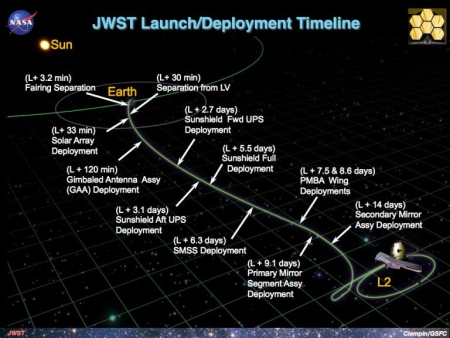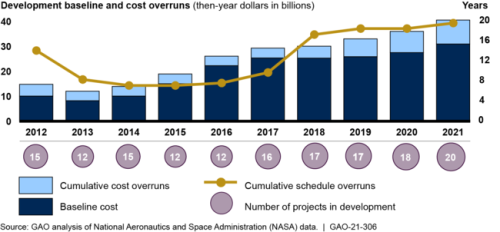Webb successfully inserted in final orbital position at the Sun-Earth Lagrange point
The James Webb Space Telescope today successfully completed a five minute firing of its engines to place it at the Sun-Earth Lagrange point dubbed L2.
Webb’s orbit will allow it a wide view of the cosmos at any given moment, as well as the opportunity for its telescope optics and scientific instruments to get cold enough to function and perform optimal science. Webb has used as little propellant as possible for course corrections while it travels out to the realm of L2, to leave as much remaining propellant as possible for Webb’s ordinary operations over its lifetime: station-keeping (small adjustments to keep Webb in its desired orbit) and momentum unloading (to counteract the effects of solar radiation pressure on the huge sunshield).
Engineers will spend the next three months aligning the segments of Webb’s large primary and secondary mirrors, while they wait for the telescope to cool down to the ambient very cold temperatures required for it to detect the tiny infrared heat emissions from very faint very very very distant objects.
The James Webb Space Telescope today successfully completed a five minute firing of its engines to place it at the Sun-Earth Lagrange point dubbed L2.
Webb’s orbit will allow it a wide view of the cosmos at any given moment, as well as the opportunity for its telescope optics and scientific instruments to get cold enough to function and perform optimal science. Webb has used as little propellant as possible for course corrections while it travels out to the realm of L2, to leave as much remaining propellant as possible for Webb’s ordinary operations over its lifetime: station-keeping (small adjustments to keep Webb in its desired orbit) and momentum unloading (to counteract the effects of solar radiation pressure on the huge sunshield).
Engineers will spend the next three months aligning the segments of Webb’s large primary and secondary mirrors, while they wait for the telescope to cool down to the ambient very cold temperatures required for it to detect the tiny infrared heat emissions from very faint very very very distant objects.


